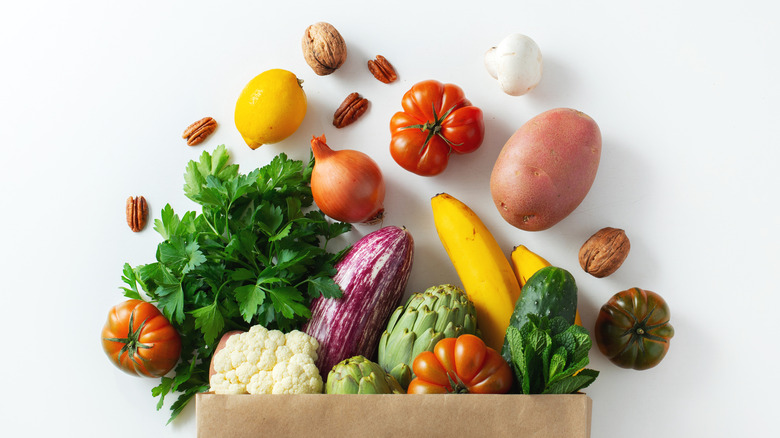The Order Of Ingredients On A Label Means More Than You Think
Let's be real. If you've ever casually browsed the aisles of a grocery store, chances are you've picked up a box, bag, or bottle to inspect the chart of nutritional facts or the list of ingredients on the packaging. Perhaps you do this because you have a specific food allergy or other dietary restrictions and have turned this into an important habit. Or maybe you want to make sure the product contains or omits something in particular. Who knows? It's also possible that you're just totally and utterly curious to see exactly what's in the item you're about to toss in your cart (and then feed yourself and your friends and family). The food and drink labels are an extremely helpful source of information for those who want to know how many calories, carbohydrates, or fats they're consuming per serving. They're also legally required to be there.
Food labels are designed in a specific way, as they have to abide by certain regulations and communicate products' nutritional contents to shoppers. Here's why food and beverage packaging labels mean way more than some people may realize.
Does the order of ingredients listed on food and drink packages mean anything?
Because nutritional labels don't list ingredients alphabetically, you might wonder if the order on your label has any significance. The short answer is yes, the ingredients you see on the labels of your food are indeed sorted in a very strategic manner. According to the Food and Drug Administration, the ingredients are actually listed in order of the predominance of their weight, from most to least. In other words, the ingredient used in the greatest amount is always listed first, and the list descends from there (per National Institute of Aging).
To keep consumers safe and satisfied — a top priority of food manufacturers — the U.S. government requires all of the ingredients contained in packaged foods and nonalcoholic beverages to be made 100% transparent. That way, people know what they're eating and drinking! As a matter of fact, the FDA has an official record of more than 4,000 ingredients in a massive database that's fittingly named "Substances Added to Food." The database includes key information about every single legal ingredient, such as additives and coloring, that can be added to our everyday foods and drinks.
Are there certain ingredients to look out for on labels?
As we've all seen at one point or another, some ingredients that are listed on labels have long-winded, unfamiliar, and scientific names. Every single food and drink we consume — from freshly-picked fruits and raw vegetables to pure spices to factory-made snacks, meals, and liquid refreshments — is composed of a variety of chemical compounds that directly influence color, texture, flavor, color, and nutritional value. However, all food ingredients, including flavor- and color-enhancing additives such as vitamins, minerals, sugars, dyes, emulsifiers, stabilizers, and thickeners are well-regulated by protective federal organizations so that shoppers can make informed decisions about what they put into their bodies and know that each label at the store is accurate.
While the term "additive" may seem intimidating to some consumers, it's good to know that not all additives are necessarily a bad thing. In fact, the term is widely misunderstood. Many key naturally-occurring and beneficial nutrients — like fiber, antioxidants, and spices — are added to packaged goods in order to improve freshness, add nutritional value, and boost texture and taste, as the FDA states.
Are all ingredients created equally?
Of course, it's extremely important to understand the significance of certain ingredients, as well as to be aware of the many different terms for pretty much the same thing. For example, there are various types of added sugars that can be found in different types of products, including glucose, fructose, and sucrose, plus some less common types like galactose and maltose (per Healthline). Sugar is usually added to foods in order to sweeten the flavor, alter the overall texture, and/or extend the shelf life. And for the most part, our bodies digest most sugars in basically the same way, according to Self.
In any case, ingredients are what make up the foods and drinks we love and enjoy. Whether it's in the form of a quick snack, a sustainable meal, a tiny sip or giant gulp, or a way to keep ourselves hydrated and satisfied, they are what keep us alive and healthy. Now that you know the major significance of the order of ingredients on your favorite foods' and beverages' labels, you can hopefully shop a bit more confidently. Fun fact: Next time you pick up a package of Goldfish crackers, take a brief moment to read the label. You'll notice that the first listed item is, of course, smiles. Happy grocery shopping!



